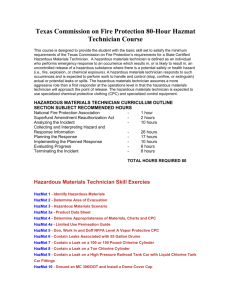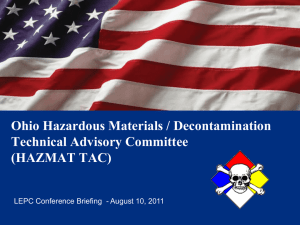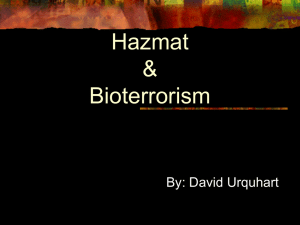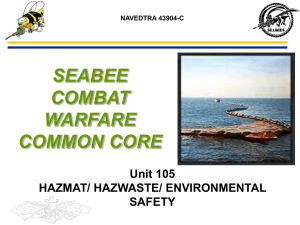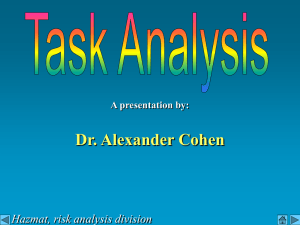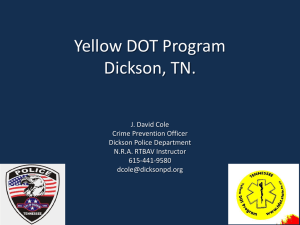(HazMat)Transportation Compliance Program
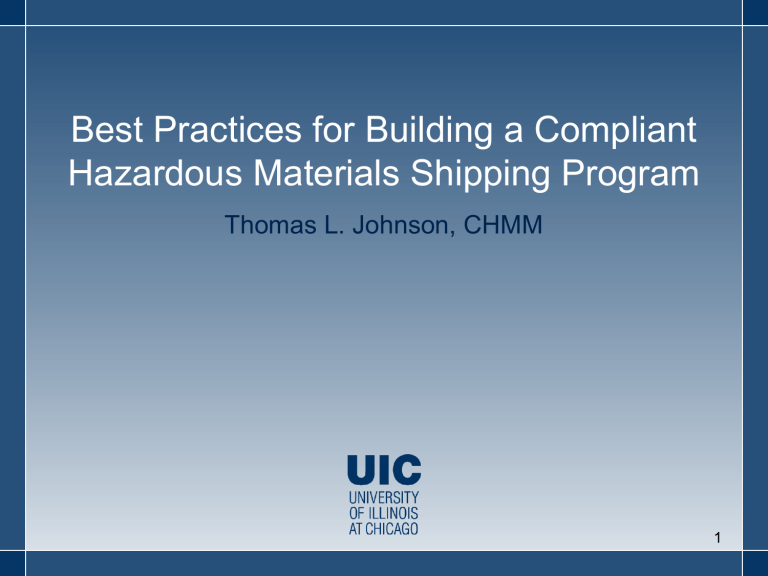
Best Practices for Building a Compliant
Hazardous Materials Shipping Program
Thomas L. Johnson, CHMM
1
Objectives
To enable you/your employer to:
• Identify hazmat employees/functions
• Shape training objectives
• Select training methods & materials
• Identify costs that come with training
2
Demographics of UIC
• Student body population: ~25,000
• Employee body population:~15,000
• Teaching hospital
• Over 1,400 wet laboratory spaces
• EHSO has 18 Full Time Technical Staff
3
UIC Program Challenges
UIC has found it difficult to find staff capable of understanding the complex DOT and ICAO/IATA regulations.
• Difficult to identify all hazmat employees
• Difficult to get department “buy-in” for training
4
UIC Program Instructors
• Training responsibility:
– Environmental Specialist
– Chemical Specialist
– Biological Safety Officer
– Asst. Director for Chemical Safety
• Program has changed multiple times in the last 5 years
5
Negative Effects of Non Compliance
• Impact of research could be delayed
• Occupational exposure
• Increased enforcement activity against Universities
6
Negative Effects of Non Compliance:
• University of Pennsylvania Health System was fined $7K for improper ground shipments
• Hackensack University Medical Center was fined $9.7K for shipping infectious substances as biomedical waste in unauthorized packaging, as well as for not having training records
7
Negative Effects of Non Compliance:
• University of Michigan Federal Aviation
Administration (FAA) received a citation for improper Dry Ice shipments
• Field Environmental Instruments, Inc., (FEI) were charged with willfully causing Federal
Express to illicitly transport pressurized gas cylinders by air
8
Who needs DOT/IATA Training?
Answer : Hazmat Employees
9
DOT & ICAO/IATA defines a Hazmat
Employee as a person who:
• Loads, unloads or handles hazmat
• Prepares hazmat for transportation
• Is responsible for the safety of transporting hazmat
IATA DGR Table 1.5.A shows minimum training requirements
10
UIC Hazmat employees are:
1.Those whose function is to only receive packages (including administrative staff)
2.Dock Workers
3.Researchers (who ship)
4.Hazardous Waste Employees
11
UIC Hazmat Employees Training
Course List
Hazmat Employee Group
Administrative Staff & Research
Staff, Receiving only
Training Course
Online “Introduction to Shipping and Receiving” Course
Dock Workers
Hazardous Waste Workers
Researchers, Shipping clinical samples
In person “DOT Awareness for
Dock Workers” Course
In person “DOT Hazardous
Waste” Course
In person “Class 6.2 Shipping and Receiving” Program
12
Training Methods Employed:
UIC administered DOT training in two ways depending on the hazmat employee:
• Self Study
• In Person
13
DOT Training Method:
Self Study, Manual Based
• All new Hazardous Waste hires had to go thru initial training per our departmental Standard Operation
Procedure (SOP)
• Training consisted of a single module
14
DOT Training Method :
Self Study, Manual Based
Advantages of this style of training:
• Low Cost
• Minimal effort to deliver training
• Training completed on employees’ schedule
15
DOT Training Method:
Self Study, Manual Based
Disadvantages of this style of training:
• Little understanding of the regulations
• No 49 CFR on site to reference
• No Student/Instructor interaction
16
DOT Training Method:
Self Study, Computer Based
Dept. of Transportation DVD-Rom
17
DOT Training Method:
Self Study, Computer Based
Advantages of this method:
• Program contained exercises for testing knowledge
• Inexpensive to purchase ($25/disk)
• Training completed on employees’ schedule
18
DOT Training Method:
Self Study, Computer Based
Disadvantages of this method:
• Was limited to few licenses
• Employees’ can be distracted or interrupted
• No Student/Instructor interaction
19
Transportation Programs
Without proper documentation and communication, any program runs the risk of no longer being implemented.
UIC experienced this first hand.
20
Reassessment of Class 6.2 Program
Catalyst:
• Biological Safety officer leaves campus
Training program abandoned:
• International Civil Aviation Organization
(ICAO)/International Air Transport
Association (IATA) Shipping and
Receiving of Class 6.2 materials
21
2008 Goal: Update and Improve
Training Program
Possible methods of training:
• Self Study- keep current method used
– Saf-T-Pak Reference Manual
• On line
• Classroom
22
Infectious Substance Shipping
Program Responsibility:
Majority of Universities, this specific program would reside with the Biological Safety Officer
This can also vary university to university:
• Environmental Officers
• Contractors
• Research Office
23
Advantages of the Hazardous Waste
Professional Responsible for Class 6.2
Program
1. Already trained in DOT regulations
2. Familiar with selecting proper packages
24
Disadvantages of the Hazardous Waste
Professional Responsible for Class 6.2
Program
1. Waste is not allowed to ship via air, so rare to have waste professionals know these rules.
2. Retraining cycle different than
DOT (2yrs versus 3yrs)
25
Advantages of the Biological Safety Officer
Responsible for Class 6.2 Program
1. Most hazmat shipped via air at a university are biological samples
2. Discovers hazmat employees through IBC review process
3. Best knowledge of infectious organisms
26
Disadvantages of the Biological Safety
Officer Responsible for Class 6.2 Program
1. Generally not trained in DOT regulations
2. Not familiar with shipping materials in other hazard classes
27
Advantages to this training method:
• Same as Manual based self study method
28
Disadvantages to this training method:
• Does not explain all pertinent ICAO/IATA regulations (i.e. operator variations)
• Must purchase the updated manual every year
• No way to confirm the employee(s) actually read or understood material
• No reference materials for users to keep
29
Reassessment of DOT Program
Departure of two key departmental employees (Chemical Specialist &
Environmental Specialist)
Two programs forgotten:
• Dock Worker DOT Training
• Hazmat Security Awareness
30
Dock Worker Training Topics
• Recognizing and responding to security threats
• Placarding requirements
• Loading, unloading, segregation rules
• Working with carriers
31
Hazmat Security Awareness
• Little information given
• No mechanism to integrate with other Hazmat training
32
Restructure of Programs
New Asst. Director hired:
•Creates training matrix for UIC laboratory workers
•Trainer sent to DOT/IATA “Train the
Trainer” courses
33
Restructuring of Programs
IATA training
•Sent to IATA 4 day class to become trainer
•Sets aside dept. funds for reference materials
•Sets aside dept. funds for refresher training (IATA trainer on 1 yr cycle)
34
IATA Train the Trainer Course
•IATA 4 day class curriculum
–Write training objectives and formulate test questions
–Prepare visual aids required for the training unit
–Understand and apply adult learning principles
–High cost class ($3,000) & limited locations
35
Restructuring of 49 CFR training
Programs
•Sets aside funds for training materials
•Sets aside funds for formal training of trainer (trainer on 1 yr cycle)
36
Results of Restructuring
37
Current ICAO/IATA Infectious
Substance Shipping/Receiving Program
•Classroom setting
•2-3 hours length
•Focuses on Class 6.2 and Dry Ice
•Hands on Approach
38
Current ICAO/IATA Infectious
Substance Shipping/Receiving Program
Materials Provided:
• Copy of presentation slides
• IATA Dangerous Goods
Regulations (DGR) sections
1,2,3.6,3.9,6,8
• Pen, Pencil and Highlighter
39
Current ICAO/IATA Infectious
Substance Shipping/Receiving Program
Attendees are shown and work with:
• What the proper labels are and how to use them
• Differences in UN performance packages
• How to cross reference their specific DGR sections
• How to create the necessary paperwork
40
Current 49 CFR Program Status
Multiple tracks created depending on task performed
• Administrative staff/Researchers
• Dock worker
• Hazardous Waste worker
41
Current 49 CFR Program Status
Administrative and Research staff, receiving only:
• Online Introduction class (1hr)
42
Current 49 CFR Program Status
Dock Workers Training: In person at jobsite
• Introduction class (1hr)
• Function specific (1hr)
• Hazmat Safety awareness (1hr)
43
Current 49 CFR Program Status
Hazardous Waste Workers Training:
Lecture Format
– Introduction class (1hr)
– Function specific (8 hr)
– Site Specific Hazmat Security awareness (1hr)
Note: Does not include OSHA Hazwoper
44
Advantages to In Person Training
• Provides hands-on experience
• More credible training method
• Gaps in programs found and can be corrected
• Questions can be presented
45
Disadvantages to In Person Training
• Class schedule conflicts
• Can be high cost
• Instructor must be available and capable of training
• Large time commitment
46
Program Creation Process
47
Program Costs
Costs vary depending on what method you decide works best for your organization
Computer based self study:
– $109 for one software license
Manual based self study:
– $165 for a Saf-T-Pak reference manual and one exam
48
Program Costs
Lecture based training, contractor:
– ~$300 per person for a 1 day class
Lecture based training, in house:
– ~
150-250 hrs. a year dedicated to teaching and program administration
– ~$72 per student trained
49
Building your Training Program Pre
Planning:
• Observe building loading docks to see where hazmat is going
• Start to figure out who your hazmat employees are
• Learn if your employer has a preferred shipping vendor (UPS, FedEx)
• Explain to your Dept. Head, Dean, Vice
Chancellor the reason for a program
50
Building your Training Program Pre
Steps:
It takes a group effort to identify all of your hazmat employees
• Laboratory Inspections
• IBC Review Process
• Laboratory Safety Training
• NIH Grant proposals
These are some methods that help to find your hazmat employees
51
Building your Training Program
Step 1 : Define what you need i.
Define your site hazmat functions ii. Define your hazmat employees iii. Shape your overall training objectives iv. Shape your function specific training objectives
52
Building your Training Program
Step 2: Program Selection
• Decide which training method(s) will work best
• Set a realistic training program start date
• Decide where the program(s) will reside
53
Building your Training Program
Step 3: Program Creation
Core Components for DOT Program
• Function specific
• Security Awareness
• Record Retention (3 yr)
54
Building your Training Program
Step 3: Program Creation
Core Components for ICAO/IATA
Program
• Function specific
• Security Awareness
• Airline specific rules
• Record retention policy (2 yr)
55
Building your Training Program
Step 4: Pilot Program
• Test your program on a mixed audience
– Include any handouts
• Refine the program from the test run(s)
• If using computer based method, make sure program works with PC and Macs
• Completion certificate should list when trainee is due for refresher
56
Building your Training Program
Step 5: Roll out
• Advertise what your training class is and why someone must attend
• For Lecture method-setup multiple days/times for training classes
• Use evaluation sheets to improve program
• Be ready to defend your program when inspected
57
Building your Training Program
Step 6: Recordkeeping Requirements
• Document your definition of hazmat employee
• Copies of your training program materials
• Name and address of the trainer
• Copy of certification that the trainee was trained and tested as required
58
Issues Seen Moving Forward
1. No back up to take over program(s).
2. No mechanisms for new hire notification.
3. Contractors on campus could ship/receive hazmat.
4. Not capturing all University hazmat employees.
59
Alternative Model: Dangerous Goods
Specialist, Central Shipping &
Receiving Point
1. Direct control of shipping and receiving of all hazmat for a University.
2. Would need only one person to maintain his/her training instead of multiple individuals.
3. No need to have a university-wide training program with this method.
60
Conclusion
• There is no such thing as a best method
• Key to document roles and responsibilities
• Training programs must be living programs
61
Thank you for your time today
• Floor open to Questions
– Contact Information
Thomas L. Johnson, CHMM
1140 S. Paulina St.
Rm.245
Chicago, IL 60612
Email-tjohns16@uic.edu
Phone-312-413-2436
62
